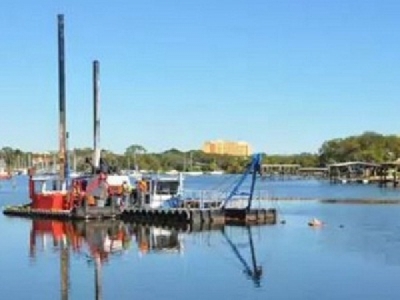
Posted on February 6, 2017
Dredging has begun in the befouled Eau Gallie River to remove a half-century of muck, a carpet of black gunk that is known to strand even canoes.
“You can go, but your outboard motor will just turn thick sludge,” said Matt Culver, Brevard County’s boating and waterways program coordinator. “It’s like going through pea soup.”
The ambitious $24 million dredging project will remove at least 632,000 cubic yards (about 42,000 dump truck loads) of muck from the main stem of the Eau Gallie River and the southern branch of its tributary, Elbow Creek, by the end of 2018. That will remove 1,200 tons of nitrogen and 260 tons of phosphorous from the river, according to the St. Johns River Water Management District, which is overseeing the project.
Scientists say dredging out muck could vastly improve the lagoon, and better land-use practices are needed to prevent more muck from entering the estuary, News 6 partner Florida Today reported.
Excess nitrogen and phosphorus in muck trigger algae blooms that kill fish and seagrass habitat for shrimp, crabs and other marine life. Biologists also find a higher incidence in Brevard County’s muck-laden hot spots than elsewhere in Florida of a strange cancer in redfin needlefish — an important bait fish.
Muck harms seagrass growth and the fish and organisms that need seagrass to survive. It contributes to bacterial decay, which consumes oxygen, causing fish kills. It also produces noxious chemical compounds, such as the hydrogen sulfide that creates the lagoon’s occasional rotten-egg smell.
The river’s bottom muck resembles “black mayonnaise” that in some spots is more than 12 feet thick. It’s mostly soil runoff from sod, construction sites, farming and erosion but also rotting algae and dead plants.
The dredged-up muck will be pumped onto property owned by Brevard County next to the Sarno Road landfill, where the water content will drain out, then the muck will be transported off-road directly to the landfill property for disposal.
During the permitting process, tests for hazardous materials found that the muck poses no health risk, water management district officials said.
Residents lobbied for decades to get the Florida Legislature to fund the project.
Wind, boat traffic and storms stir muck in the water, clouding the water and killing seagrass.
The dredging project is contracted to Blue Goose Construction, based in Fort Pierce.
The dredging will be performed from the confluence of the Eau Gallie River with the Indian River Lagoon to the river’s Control Dam to the west, and in Elbow Creek from the confluence with the river to the Magnolia Avenue Bridge and the Laurie Street Bridge.
The project permit requires dedicated manatee observers to be on site. They must alert workers to stop the dredge whenever a manatee swims within 50 feet of any in-water activity.
To further protect manatees, no dredging will be done within the Eau Gallie River or Elbow Creek from March 1 through April 30, and restricted portions of the lagoon – where manatees could become trapped – are closed to dredging from Nov. 1 to May 31.
Source: Click Orland.com





